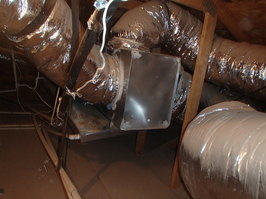
Remember the Gremlins movie where cute little furbie creatures with huge ears made every child want to snuggle up with until they came into contact with water and transformed into ravenous looting monsters The story goes that the old man that gave the Gremlins away warned its new owner to avoid contact with water but despite a half-hearted prevention effort, the original creature comes into contact with water and the trouble begins as the Gremlins multiply and take over the town.
There’s plenty of Gremlins that are hidden in your house that keep your energy bills higher than they should be and cause hot rooms and temperature differences despite efforts to save be energy efficient at home. These home energy Gremlins remain hidden from view but are counteracting the positives of energy upgrades you may have tried like using a time of use plan or replacing your windows or air conditioner. If you have seen lack luster results from your energy saving efforts, start looking for these Home Energy Gremlins.
Performing a whole home performance upgrade instead of a one upgrade approach
A specialty contractor takes the point of view of that everything is a nail and they are the hammer. The problem with this is that homeowners looking to reduce their energy bills or fix comfort problems will likely be disappointed from this approach because these problems aren’t often fixed with just one approach, be it solar, windows, insulation, Aerosealing or radiant barrier and solar attic fans. Our energy auditors have seen all too often homes that have plenty of insulation in the attic by an insulation contractor, Aerosealing done by an air conditioning contractor or new windows installed by a window contractor and the results fall far short of the promised results. Sometimes the contractors just don’t know the best way to truly upgrade a home is a whole home approach and education. Other times contractors are over ambitious in their savings and product estimates. When push comes to shove, there is no way to know what a home needs until a whole home energy audit is done by a qualified company.

The wrong sized HVAC unit
A home could have all the right upgrades- new windows, spray foam in the attic, a tight house and duct system and even a new AC unit on, but putting the wrong sized HVAC system on the home is an energy Gremlin that could turn in real ugly real fast. Too big a system and the air conditioner will turn on and shut off like a kid who’s had too much candy and can’t sit still, we call it short cycling. An air conditioner that short cycles wastes a ton of energy because these boys spike in energy use just to turn on, almost ten times the energy is used to turn the AC unit on as it takes to run it at a steady state. At start up, a compressor has to immediately move a lot of refrigerant through the unit and compressors need extra torque to overcome higher pressure sitting on the compressor cylinder head at startup. The load calculations we have done to determine the proper air conditioner size in Phoenix reveal about half of the systems we look at are oversized. I love putting a smaller and properly sized air conditioner on a home but that is a topic for a different post.

We have seen attics with perfectly sealed ductwork, well insulated attic floors and had done all the right things on the surface but the energy bills were still sky high and there was weak airflow in some rooms. After performing a home energy audit we found that their problem wasn’t with the quality of previous work, it was the ductwork size and layout was wrong. Oversized or undersized ductwork can be a huge problem that can cause the most energy efficient air conditioner to act like a 30 year old system in terms of efficiency. Imagine a 5 ton air conditioner that’s getting only 4 tons of air? It doesn’t matter how efficient the unit is its not getting enough air into the system, it’s going to be overworked and stress the unit and your energy bills.

The fourth home energy Gremlin is the insulation. This isn’t just how much is up in the attic, it’s also how the insulation is installed. Even on newer homes if the insulation is installed wrong (or missing completely), it can cause hot spots and lower the entire attic’s R-value, or its ability to resist heat flow. On older homes the level of insulation may have settled and the attic is likely under insulated. The Department of Energy recommends a R38 or 12” of cellulose or 16” of loose fill fiberglass in Arizona attics. The cost effective threshold is about R26, where if you have 8.5” of cellulose now the cost savings isn’t as great as homes with less than 8.5" of cellulose.

Motors and pumps are the Dark Horse of home energy Gremlins, they often go unnoticed until they break down or one of our energy auditors shed light on these potential Gremlins. A motor can be in the form of a pool pump, recirculation pump or in your HVAC system. The recirculation pump is an effective way to get hot water fast to a faucet far away from the water heater but these pumps are rarely set correctly and forgotten about. How much can your energy bills increase from an improper recirculation pump setting? Try the tune of $60 a month! With that much energy waste it’s no wonder your energy bills having gone down even with a new AC system or windows.


 RSS Feed
RSS Feed
